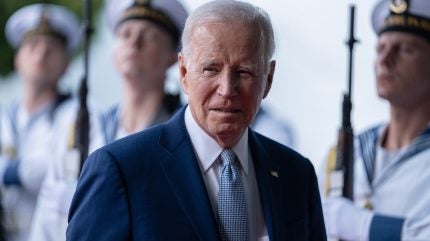
As the US unveils its defence budget for Fiscal Year 2025, a closer examination reveals shifts, budgetary constraints, and geopolitical ramifications, sparking debates within and beyond Capitol Hill.
In a labyrinth of strategic manoeuvres and fiscal constraints, the unveiling of the US defence budget for Fiscal Year 2025 (FY25) illuminates the intricate dance between national security imperatives and budgetary realities.
How well do you really know your competitors?
Access the most comprehensive Company Profiles on the market, powered by GlobalData. Save hours of research. Gain competitive edge.

Thank you!
Your download email will arrive shortly
Not ready to buy yet? Download a free sample
We are confident about the unique quality of our Company Profiles. However, we want you to make the most beneficial decision for your business, so we offer a free sample that you can download by submitting the below form
By GlobalDataThe combined budgetary proposal is over $849.8bn, including a proposed budget totalling $217.5bn for the Department of the Air Force (DAF) alone, representing a $2.4bn increase over the FY24 request. This comes amongst other allocations for various defence branches and international aid; the Biden administration’s blueprint aims to fortify America’s defence posture amidst a backdrop of global tensions and economic uncertainties.
The “decisive decade”
The proposed budget, totalling $849.8bn for the Department of Defense (DoD), reflects a blueprint to fortify national security in what Secretary of Defense Lloyd J. Austin III describes as the “decisive decade.”
President Biden’s defence budget proposal reveals a delicate balancing act between prioritising military readiness and navigating fiscal constraints exacerbated by inflationary pressures. With a proposed increase in defence spending, particularly for modernisation efforts and joint force readiness, the administration seeks to address capability gaps and technological advancements essential for confronting emerging threats from peer adversaries such as China and Russia.
Central to the budget’s ethos is integrated deterrence, tailored to counter evolving threats from the PRC and Russia. Notably, the $49.2bn allocation towards modernising the nuclear triad underscores the imperative of maintaining a credible deterrent posture amidst global uncertainties.
However, one area of contention is the discrepancy between the proposed budget and the Department of Defense’s (DoD) actual needs to effectively compete with adversaries like the People’s Republic of China (PRC) and Russia.
Amidst growing concerns over inflation and its impact on defence expenditures, questions arise over the adequacy of the proposed budget to meet security challenges. Critics argue that the discrepancy between budgetary allocations and the actual cost of sustaining military capabilities remains a point of contention.
Washington, DC – US Representative Mike Rogers, Chairman of the House Armed Services Committee, released the following statement on President Biden’s budget for Fiscal Year 2025 (FY25).
“The President’s budget request complies with the mandated numbers of the FRA. Unfortunately, this defence topline number fails to keep pace with inflation and our adversaries.
“I have been saying this for some time now – our defence budget should be built with the goal of deterring the threats facing our nation. Instead, we are forced to build a budget to meet an arbitrary number. I worry about the long-term impact this budget process will have on our national defence.”
Geopolitical chessboard
Against shifting power dynamics, the defence budget is a barometer of US strategic priorities and international commitments. President Biden’s proposed reduction in Foreign Military Financing (FMF) aid to Ukraine raises concerns about the future of US support for Ukraine amidst escalating tensions with Russia. The proposed $95m allocation for Ukraine marks the lowest FMF package since 2018.
Following the attack by Hamas into Israel on 7 October 2023, President Biden asked Congress for an additional $14.3bn for missile defence and military financing, but Congress has not sent a final bill to the president’s desk, as per GlobalData’s “US Defense Market 2023-2028” report.
As the US seeks to address regional defence challenges, allocating resources towards emerging threats, including hypersonic missile capabilities and cybersecurity protection, reflects a nuanced approach to safeguarding national interests.
With a looming national election and the spectre of former President Donald Trump’s influence, domestic political dynamics further complicate the geopolitical landscape and raise questions about the continuity of US foreign policy commitments.
The outcome of the US 2024 elections is poised to significantly impact global politics and defence spending, with Democrats and Republicans pledging varying approaches to military aid and international involvement. While the baseline military budget is unlikely to see significant fluctuations, ongoing debates over aid to Ukraine and other allies will persist, contingent upon the election results. A potential second Trump administration could alter America’s role in Nato, the AUKUS agreement, and military aid initiatives, impacting global defence dynamics.
Investing in tomorrow
As the FY25 defence budget proposal undergoes congressional scrutiny and deliberation, the path forward remains fraught with uncertainties and competing priorities. Secretary Austin’s emphasis on matching resources with national objectives highlights a shift towards a more pragmatic approach to budget allocation.
He emphasised targeted reductions in programmes delivering key capabilities, “This budget request is consistent with the funding levels approved by Congress under the Fiscal Responsibility Act of 2023. Under these caps, we made difficult but responsible decisions focusing on maintaining our military’s readiness and taking care of our personnel.
“So our budget request reflects targeted reductions to programmes delivering key capabilities in later years to support the joint force’s ability to fight and win in the near term.”
Ultimately, the decisions made in the corridors of power will shape America’s defence posture and reverberate across the international stage, influencing the strategic calculus of allies, adversaries, and partners.
Defence budget beyond FY25
Amidst the scrutiny and debates surrounding the defence budget, one overarching theme emerges the imperative of investing in innovation and partnerships to navigate the complexities of an evolving security landscape.
As Secretary Austin emphasised, the budget prioritises investments in human capital as indispensable assets in maintaining military superiority: “This budget request also reflects a deep commitment to our people, who will always be the Department’s greatest strategic asset; we hope to raise basic pay, boost quality-of-life initiatives, and promote safety and accountability.”
Furthermore, the budget underscores the importance of strengthening international alliances and partnerships as force multipliers in addressing shared security concerns. Through the European and Pacific Deterrence initiatives, the US seeks to bolster collective defence mechanisms and enhance regional stability in critical operation theatres.
By forging closer ties with allies and partners, the US aims to project strength and unity in the face of common adversaries while reinforcing the foundations of a rules-based international order.
Projections indicate an increase in defence spending to $931.6bn by 2028, up from $818.8bn in 2023, according to GlobalData. Factors driving this surge include geopolitical tensions such as the spectre of a Chinese invasion of Taiwan, escalating rivalry with China in the Indo-Pacific region, countering Russian aggression in Europe following the invasion of Ukraine, and supporting Israel in its conflict with Hamas. These factors highlight the need for sustained growth in US defence investment and procurement initiatives.
Charting a course for national security
The defence budget for Fiscal Year 2025 is a roadmap for navigating the complexities of an increasingly contested world.
As Congress deliberates on the FY25 defence budget proposal, the stakes are high, with decisions made in the halls of power shaping the future of America’s armed forces and its role in the world. Whether the budget succeeds in balancing readiness, alliances, and priorities remains to be seen, but one thing is sure: in the decisive decade ahead, the choices made today will reverberate for years to come.




